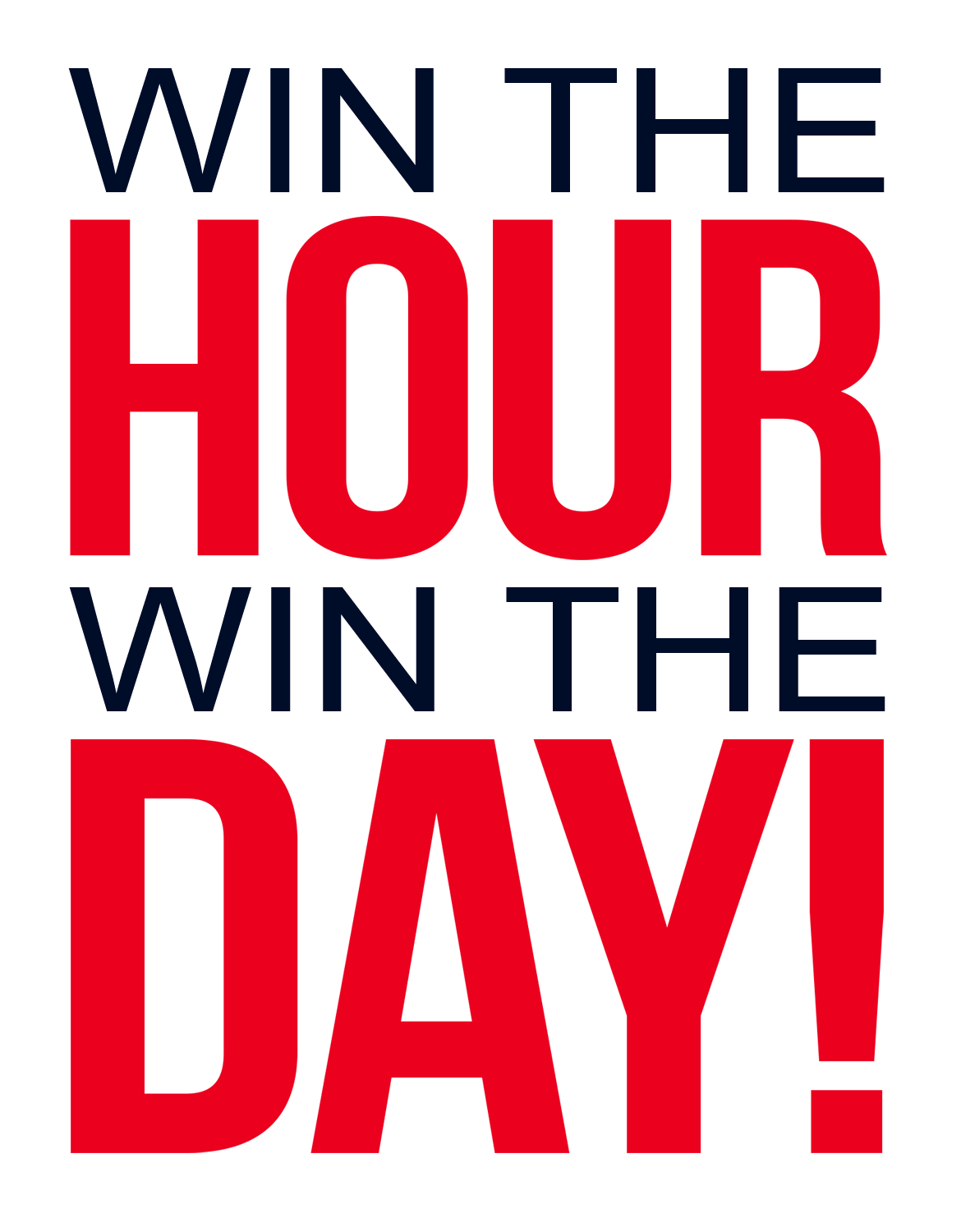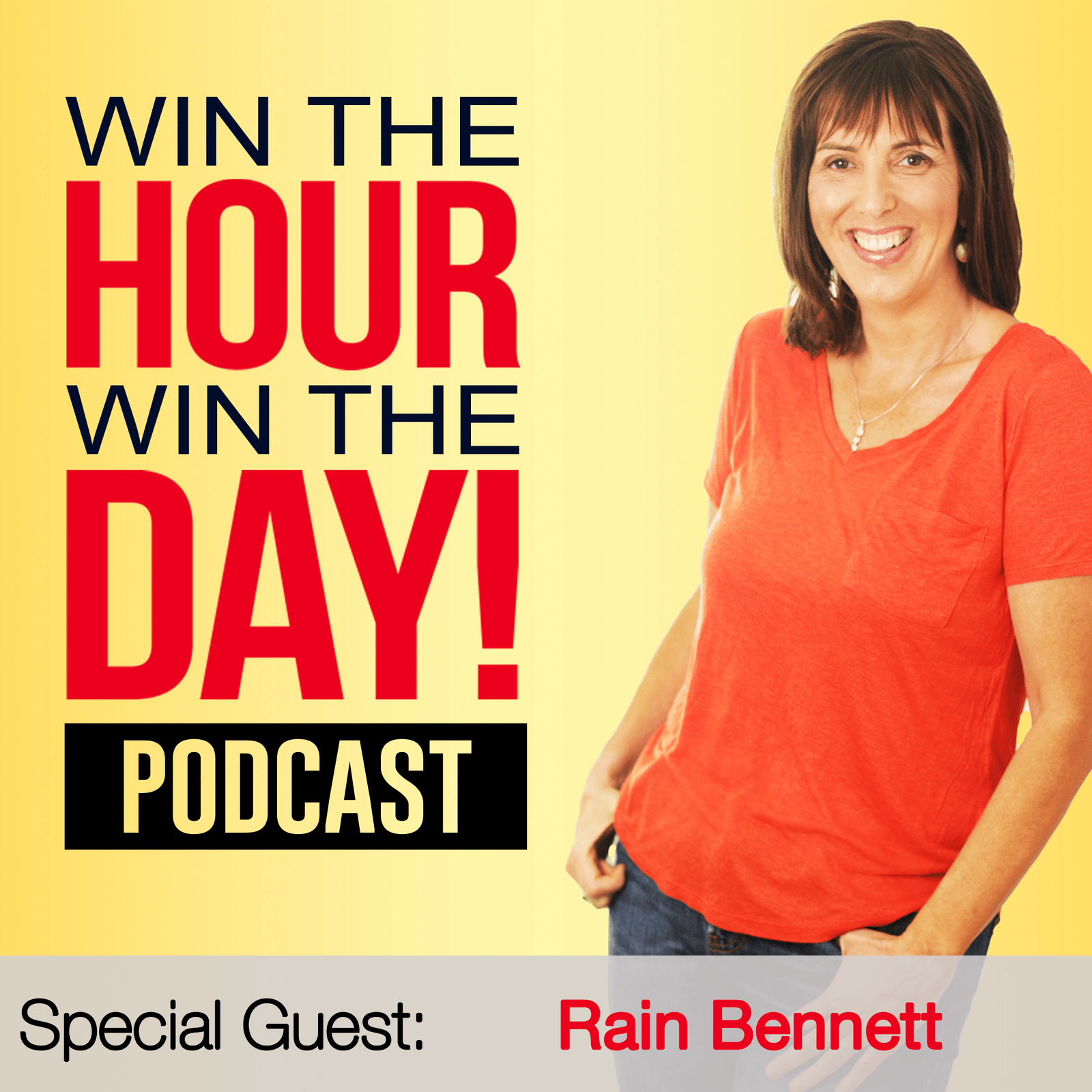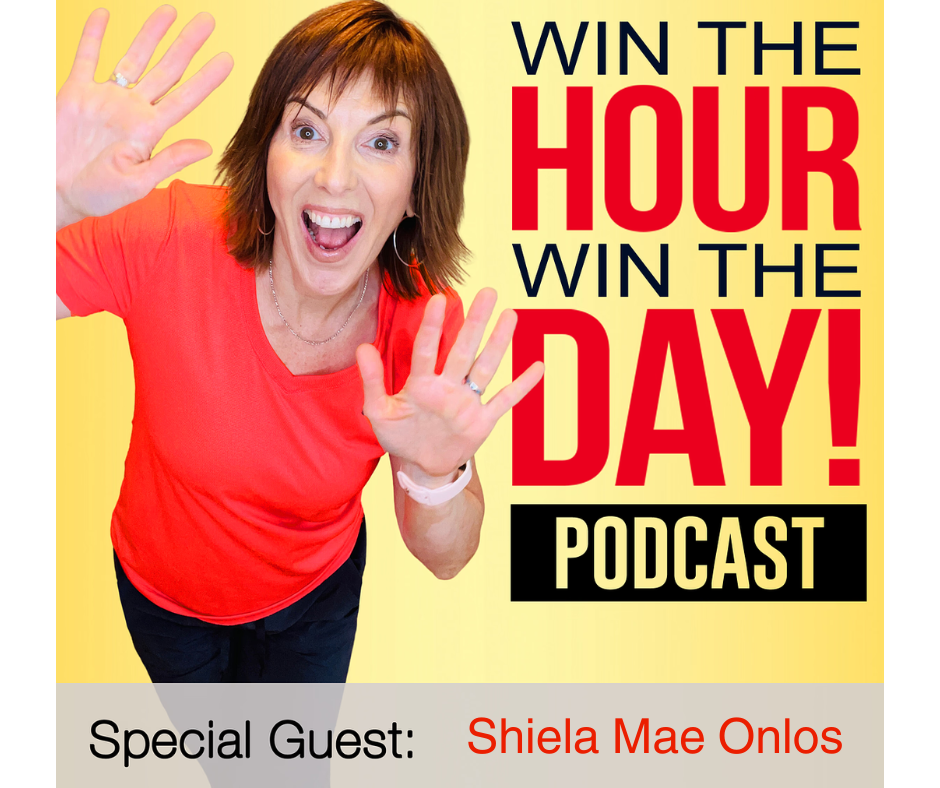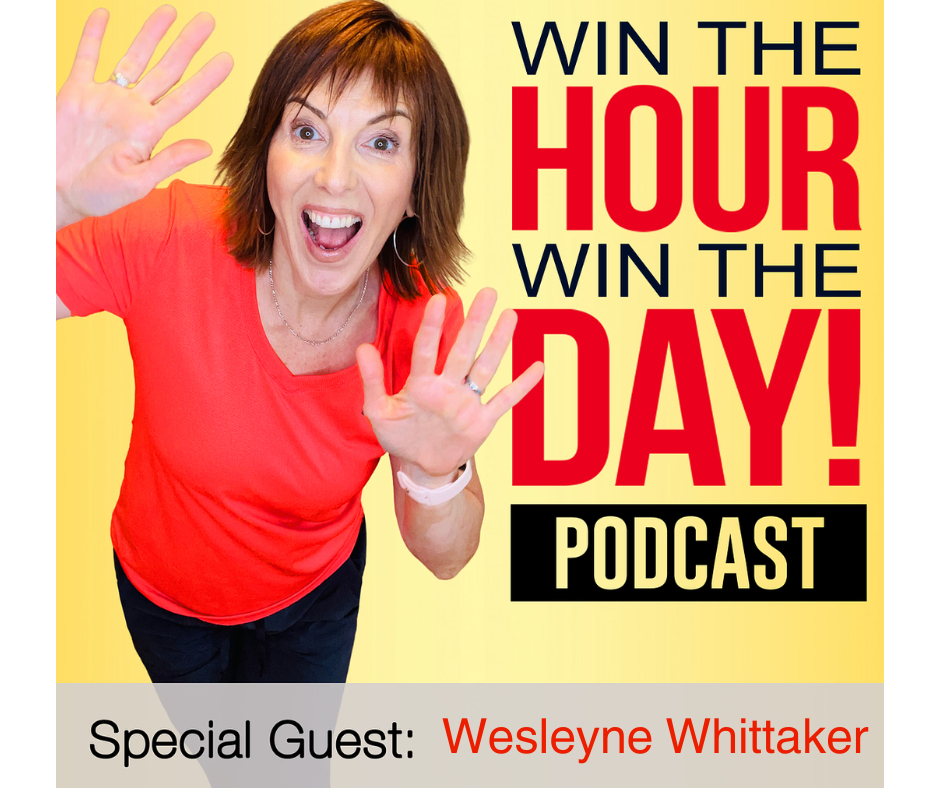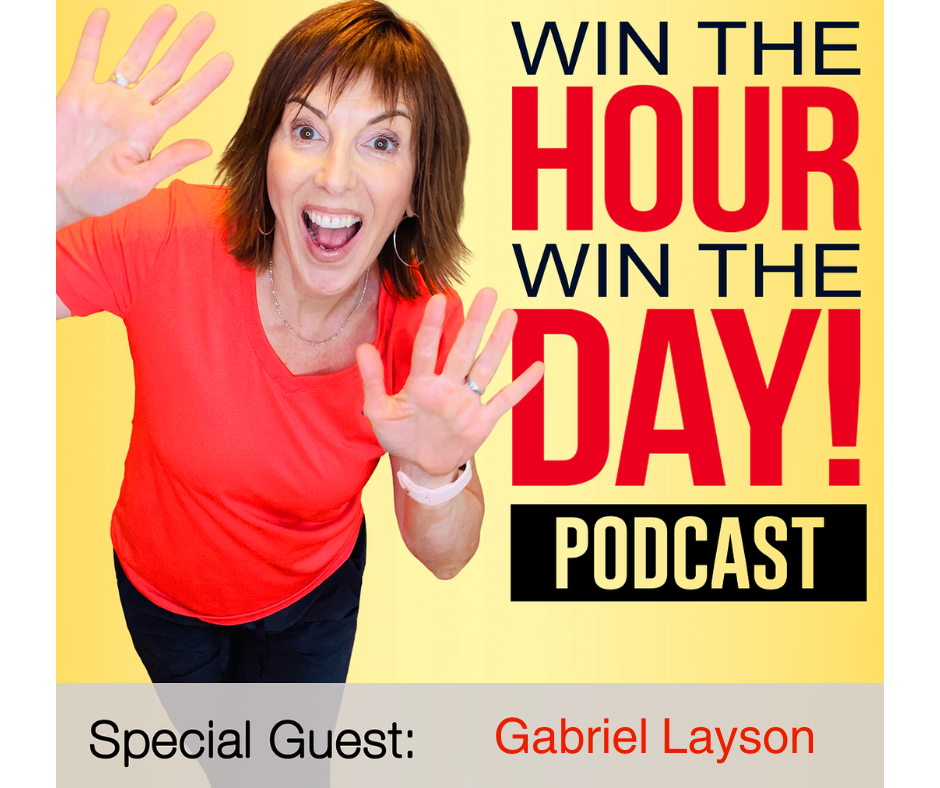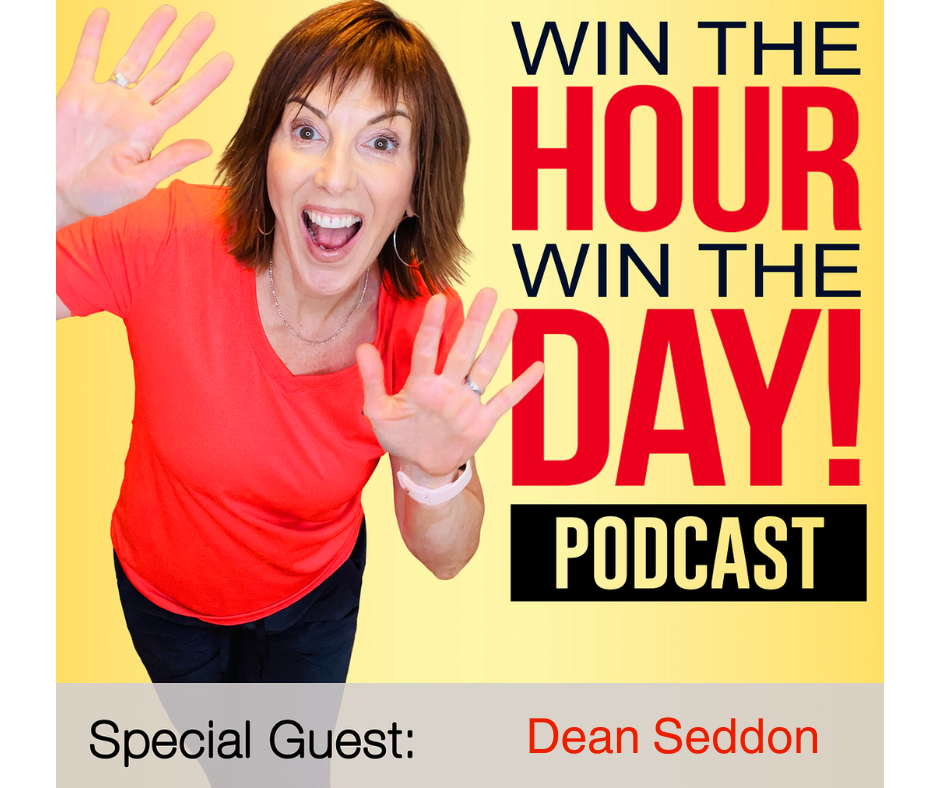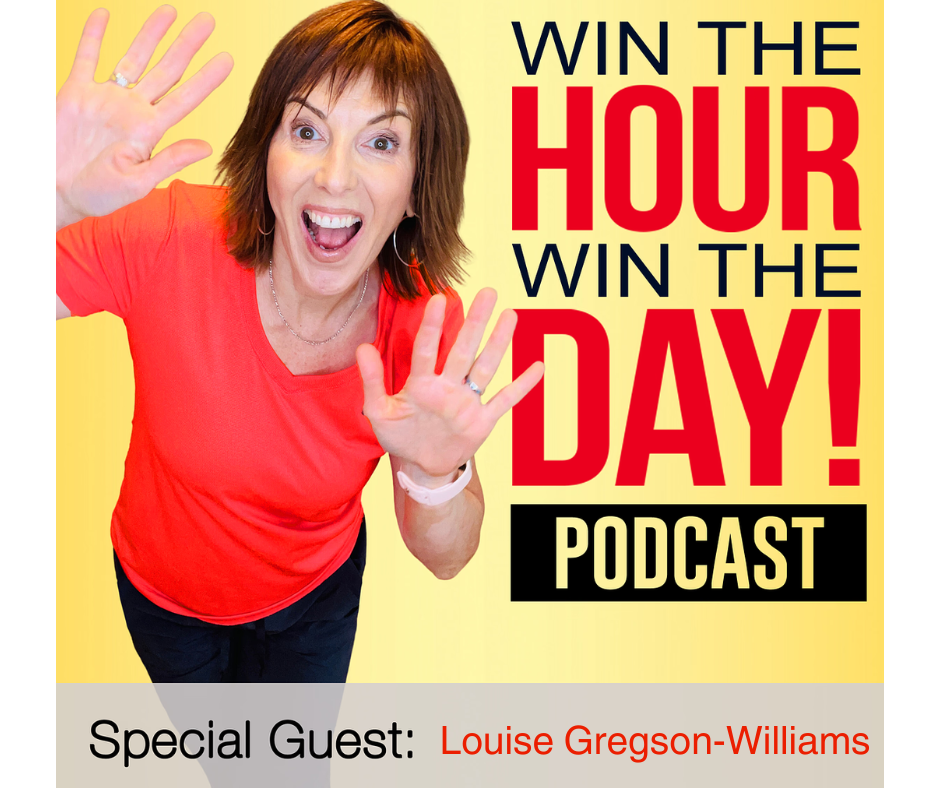Episode Summary
This week’s episode of Win The Hour, Win The Day Podcast is sponsored by Win The Hour, Win The Day’s Signature Coaching Program the Winners Circle. Kris Ward who helps entrepreneurs to stop working so hard interviews, Rain Bennett.
Rain Bennett gives us a simple but profound look at storytelling and how it can impact our small business!
Learn:
-How to construct any story using a basic formula.
-What makes a story profound and memorable.
-How you can leverage all aspects of your small business with storytelling.
-Why stories can be your secret weapon for your small business.
-How to tell an impactful story regardless of how little time you have!
And MUCH more!!!
W.I.N Time Back Quiz
https://bit.ly/WinTheHourWinTheDayScoreCard
Win The Hour, Win The Day! www.winthehourwintheday.com
Podcast: Win The Hour, Win The Day Podcast
Facebook: https://www.facebook.com/winthehourwintheday/
LinkedIn: https://www.linkedin.com/company/win-the-hour-win-the-day-podcast
Win The Hour, Win The Day Winners Circle: https://winthehourwintheday.com/winners-circle-masterclass
You can find Rain Bennett at:
Website: https://www.rainbennett.com/
Book: https://www.rainbennett.com/sixsecondstoriesbook
Email: rain@sixsecondstories.com
Instagram: https://www.instagram.com/rainbennett/
Facebook: https://www.facebook.com/rainbennettfilms/
LinkedIn: https://www.linkedin.com/in/rainbennett/
Win The Hour Win The Day
https://winthehourwintheday.com
Rain Bennett Podcast Transcription
[00:08:33]Kris Ward: Hey everyone, welcome to another episode of Win the Hour. Win the Day. And I am your host, Kris Ward.
And today, oh my gosh, we are gonna have fun. We’ve got Rain Bennett in the house and I am telling you, I don’t know if you can listen to this show while you’re driving because you are going to want to take copious notes. And speaking of notes, I just finished his book Six Second Story and it is chalk full of solid takeaways, amazing content, No fluff, and it talks about stories in a way that it has… I feel it has never been explained, or really just the profoundness of using them and their architecture of setting them up so simply and so effectively. Welcome to the show, Rain.
[00:09:19]Rain Bennett: Thank you. Thank you very much. And yes, if you are driving right now, pull over, find a rest stop. Okay. Cuz we’re gonna get into it.
[00:09:26]Kris Ward: We are. Okay. Big fan of your book. You know what? Boy Oh boy. I’ll tell you, I admitted this to you. I read a lot of books, especially if somebody’s gonna be on my show and I skim through them and there’s a certain amount of filler in every book, and that’s fine.
And I know there’s apps out there that’ll give you the highlights of any book. I don’t want that. I wanna find them myself. But yours was, I had to change my plans. I was like, Oh my gosh, I gotta get this book done. Before rain does on this show. It was. And you just, we talk about stories and stories are important.
I’ve heard the whole Yeah. We around the cave, telling stories at the beginning of time. It’s so important. Okay. We all gotta tell stories. But I think a couple things that you did that were hugely profound for me is, one – you talked about the science and how it affects the brain when we hear a story, and then you gave numerous example
tied into everyday living of, how you’re watching a movie and we know they’re actors and yet we get emotional and all this other stuff. So there’s that, and then there’s the outline and the layout of look, here’s the story, here’s how you do it. And then you gave numerous examples. It really is a fantastic, why and how to your book.
So let’s start there because I think it’s really no one really talks about this. So why don’t you just tell us a little bit about how the brain absorbs stories and why that matters.
[00:10:49]Rain Bennett: Well, listen, first of all, I appreciate the kind words that you said about the book. We worked hard on it. And it is laid out in a way, like a story where one thing leads to the next.
So there’s a lot of people that are like, just tell me how to do a TikTok video. And it’s it, we don’t talk about so much of the execution, or what we do later. But in the beginning we have to lay down this groundwork of like, how do you communicate, how your message, your thoughts, your ideas, clearly to the next person, to your audience.
So storytelling gets misconstrued as a marketing thing, right? A marketing tactic. A marketing concept. It can be certainly. But the thing is storytelling is a communication tool. A communication tactic. So you can use that for marketing, of course. But you can use it for a myriad, a million other ways because it’s about communication and connecting with other humans.
What you do with that connection depends on your mission. So yes, you can use it to market your ideas and products and services, but you can also use it to build communities and heal trauma and to find what you should be doing in your life. So all it is a way for people to connect and communicate their ideas.
And so why it’s important is because this is the big, the biggest issue that people face. How do you get what’s in your head and in your heart out to the next person?
[00:12:12]Kris Ward: I think, so I think for me though, often people will tease me and say, “Oh, I tell a good story,” but what I now realize is we’ve been misusing the word story.
I might tell an antidote of something that happened and I know to tell it quickly to get to the punchline and not to drag it out. So make it tight, make it efficient, and if it’s funny. That’s telling something that happened. Versus, that’s where I think I know for myself misunderstood stories, right?
Or I was talking in a passive event of okay, this is what happened to a client in the Winners Circle and then blah, blah, blah. And they always talk about how we get 25 hours back a week within the first month of working with us. But first of all, there’s a lot of preamble to that.
There’s no emotion, There’s no, as you talk about transformation is everything. There’s no transformation there. So I think I’m telling a story, but I’m not. Not in the beauty of what a story can empower you to do.
[00:13:16]Rain Bennett: Yes. So the way I describe a story in as simple as terms as possible is a story is a sequence of events, which you’ve alluded to. But a sequence of events that has affected change, that has created transformation, like you said. So to tell a story for whatever reason, sometimes compete in live story slams, right story competitions.
[00:13:37]Kris Ward: And who knew there was this underground world, but go on.
[00:13:39]Rain Bennett: Yeah. Yeah. There’s a really big national one called The Moth. And you might have heard the Moth Radio Hour. They have a great podcast, but yeah, there’s story competitions. So my goal there is to just entertain people and tell a great story. So you still need that transformation. Now, if we’re talking about brand storytelling, which I suppose we’re gonna spend most of our time talking about today, then there needs to be a point.
What is the goal? What is the call to action? If there’s not an objective for anything you do in business, what is the point you need to be able to measure how it’s going to be successful? So within storytelling, brand storytelling specifically, what do I want my audience to do? What is the action I want them to take?
And then you understand I have this reverse engineered model, if I can it’s not really a tangent, but it’s just going a little bit deeper. Cuz often people are like, I don’t know what story to tell. What’s going to impact people? Instead of starting with what do I say?
What story do I tell? I have people start with that end goal. What do you want people to do? Do you want them to sign up for your link, buy your product? Join the community. What is the call to action that you have for them? And then you reverse engineer it. We know that people make decisions, and this is the science that you talked about.
This is how people have always communicated always since the beginning of language. The beginning of humanity is through sharing stories, not through bullet points and information, but narrative. So we know people make decisions emotionally, so then we ask ourself what do we want them to do? The call to action.
Then the previous step, what emotion would they need to feel to be inspired to take that action and then you reverse engineer it to the first step. Okay, so what is a story or the story that I should tell to evoke that emotion, which will inspire that action? And for stories, you can’t just, we all know people that at a bar or at a networking event that just start rambling off of sequence events.
Oh it happened on Monday. Was it Monday? Or was it Sunday? It was Sunday and it was eight o’clock and all this arbi irrelevant.
[00:15:38]Kris Ward: And I remember cuz it was raining. Yeah.
[00:15:40]Rain Bennett: Who cares? Unless the rain plays a role in the story, right? I could tell a story about driving and the rain made it.
I have one actually that I tell, and the rain was a character in the story because it made things challenging and made the conflict and the stakes higher. But generally those bits of information, you’re gonna lose people. You only need these essential elements and you need to, there needs to be some transformation or some change.
Here’s where I was. The story, the journey happened and here was the result of it. It’s simply before and after that story. So that’s fine for just telling the story if you’re at a bar at a networking event. But if you do it for your business, then there has to be a point and then in the filmmaking world, in Hollywood, it’s or even in folk tales, it’s the moral of the story.
What is the theme? What are you really saying with this story about spaceships? What’s the real thing? Oh, it’s about love. Oh, it’s about, working together. Oh, it’s about letting go, whatever. There’s always a universal theme, and that’s what you need to tap into. It’s not so much about what’s happening, but what is the point?
What do you want your audience to take away from that? They’re not gonna remember every detail. So what is the feeling you want them to feel after they’ve heard or seen your story?
[00:16:53]Kris Ward: So when we do that, and I realize too that a – I know from writing in school years oh, that’s a passive voice.
So when I’m talking about a client saying this is what the client told me. I’m talking really past tense and passive, so how do I create emotion that’s not mine by the client. And I say this, this is the reality. Clients tell me all the time, Oh my gosh, Kris, you completely changed my life.
Cuz they were grinding it out, working insane hours. And we get them like 25 hours back a week within the first month of working with us. So now they start to take care of themselves. They’re exercising, spending time with their family, and they fall in love and back in love with this business. That they wanted to do in the first place, or else you could always just stay at a job that you hate versus the overhead you have for your own business.
So I get these emotional things where, you know, one guy, he teared up, he said, I didn’t even know how off track I was like, I didn’t know how much I missed my life. Now how do I tell that story that’s not mine and not my emotion?
[00:17:56]Rain Bennett: Oh the things that we connect with are going to be one – the struggle. And the feelings that those create in us, right? So that’s frustration. That’s feeling like I’ll never achieve my dreams. And also the transformation or the goal of what we’re trying, the aspiration, what we’re trying to achieve. So there’s different little bits of that, all these essential elements to a story that you can focus on.
So it’s not so much about you having to talk about, let’s call him Steve. Talk about Steve, like how Steve felt if you don’t know how he felt, but you can talk about what Steve went through and it will show, we can assume like there’s a saying, the number one rule in screenwriting and storytelling is show – don’t tell.
So it’s not about telling me that Steve was frustrated. You can tell me that Steve tried this. Steve tried that in his small business and he was never getting ahead. He couldn’t break out of this, this revenue bracket or whatever, and we can pick up what you’re putting down. Yeah, that’s pretty frustrating.
You tried this, you spent a lot of money, you still didn’t get moved forward. I get that. So we’re talking about what he experienced and your audience can feel what Steve is feeling, even if you don’t have those feeling yourself, cuz you don’t wanna speak for him and say Steve considered quitting business altogether unless Steve told you that.
But you can tell the people what Steve went through, all the things he tried and all the things he failed at and that’s gonna do it to us cuz we’re gonna think about ourselves and like all the things we tried and all the things we failed at, and we’re gonna feel those emotions just by the sequence of events.
Or conversely we can talk about, “And then Steve booked a call with Kris and the first day he immediately saw ways that he could get his minutes back each day.” And then that turned into hours and now he’s got this streamlined business. And now we start hearing those things like, Oh my God, how wouldn’t that feel?
[00:19:55]Kris Ward: Okay, so let me jump in for a sec. Here’s I get lost. Then I’m trying to make it more grounded and more present, cuz I think when I’m from talking to you, I mean it really has been a game changer. So I’m realizing how much everything was passive and past tense. So would I be better served than to say, I remember the first time I met Steve.
I thought he was a wonderful guy, in hindsight now I realize there was such a tension in his jaw and his shoulders were hunched over. Do I own it that way and move forward in this story? So it’s present time and put.
[00:20:29]Rain Bennett: No, it’s no. Don’t conflate passive voice with past tense. It’s not necessarily the same. And also this is more of a writing thing, which obviously writing is inherent in any storytelling, even if you’re doing it, but this is like a classic issue. I’m gonna pick on you a little bit, but it’s because I love you, but also so that we can learn because what I think that you might be doing here is what everybody tends to do or humans tend to do. Quite often it’s overcomplicate things.
[00:20:59]Kris Ward: Yeah, It sounds like me. I resemble that. Go ahead.
[00:21:02]Rain Bennett: It’s all of us. It really is. And so my first goal with any client, “Let’s relax. Let’s keep it simple” because we will classically do that and then sometimes we overcomplicate it so much where it gets overbearing and seems unattainable or unachievable.
So then what do we do, Kris? Then we quit. We abandon, we pivot. We don’t do it right? I always use this line and I’m totally biting it from Tim Ferris. Tim Ferris has made a whole career off of seeking efficiency in high performance. So he has a simple question, what would this look like if it were easier?
If I wanna achieve this, I wanna make a million dollars in a year. That seems really hard when I’m only at a hundred thousand or something. So what would it look like if it were easier? And it’s a good exercise we can all have. So that’s what I try to do with people in terms of storytelling.
Like all we want need to hear is there is a problem, a journey to solve that problem. And a resolution of that problem. Boom boom. Beginning, middle, and end. Okay. Like one, act two, act three. Aristotle said it thousands of years ago. That’s all it is a three act, a three part thing, a problem to overcome.
And then of course there’s other pieces of that. The feelings, the problem created, the stakes that were involved. The problem wasn’t solved. Right now we’re getting little dense and a little nuanced, right? But the very fundamental foundation is a beginning, middle, and end a problem, a journey, and a resolution.
10 years ago and now is the resolution. So that’s the present tense, but you’re always gonna have the past tense. And so it’s don’t get too caught up in “Oh, I’m telling something that happened.” That’s fine, because most journeys did happen in the past.
[00:21:44]Kris Ward: I think I was getting confused when, it’s not my story how to create emotion, but you’re right, here’s the architect of a problem, so I can still do the same thing.
[00:22:55]Rain Bennett: Totally. The emotion doesn’t come from the past or the present. It comes from the struggle. We empathize and connect with people through shared experiences, and we do it more so through shared struggles.
If I had a soccer game last night and I gotta go, people will get that and they can empathize Cool, I’ve gotten a goal before. That was fun. But what they really connect with you on is Oh my. I was at the six yard line. I was right in front of the goal and I shanked it. Then they’re like, Oh my God, dude, I’ve been there.
I know what that feels like. So shared struggles is what connects us even more than just, vaguely shared experiences.
[00:22:32]Kris Ward: Right. And I think where I was getting stuck with the Steve story was because it wasn’t my story. So I thought I was losing impact by not being able to say these were my emotions.
I was embarrassed because it was somebody else’s experience. But I think you’re right. We still have to have the transformation and I can talk, love the narration in movies. They have a third person narration.
[00:23:52]Rain Bennett: Of course. Here’s the thing, If you’re telling a brand story, this is what I call a success story, okay?
You have your own stories, but a success story would be one that you’re telling of a customer where it’s kinda like a testimonial for you. You’re helping them. And if anyone out there knows Donald Miller of the story brand world. Building a story brand. He’s one of our icons, right in the storytelling space.
I don’t believe that every story you tell should be this, but he talks specifically about brand storytelling of where you are not the hero of your story. Your customer is, your client is, you are the guide, the guru, the mentor that comes along and helps that person through it.
So you talk about Steve, he was going through this, and then when I met Steve, I was like, Oh, I think this might help you. Let me give you, a little bit of what we’ve been working on, et cetera. And then you show the transformation that you helped him have.
But it’s Steve’s story. You just play a small role in it. And you don’t have to say, “There’s no way Steve would’ve been successful without me.” You just tell ’em what you did with him and they’ll pick up what you’re putting down. Remember it, “Show not tell.” And so if Steve was struggling, then Steve worked with you and then Steve was not struggling, we can understand that, that you helped him, usher him into that new world.
Yeah, that would be a success story when you’re telling someone else, it’s very effective because you’re trying to find other Steves out there and when other Steves, when Rain sees he’s struggling with the same issue and he sees a story about Steve struggling and then he sees a solution that worked for him, maybe it can also work for me. That’s how it works.
[00:25:26]Kris Ward: And that’s the beauty of your book too. And yes, I could win the Olympics for overthinking things. Now I have, I’m recovering it. I’ve been working really hard on it. But that is the beauty of your book, is you do lay it out so simply. And then of course if you’re really talented and try really hard, you can take that simple a formula and then try to mess it up by adding, “Oh, what if it’s third party story?”
Okay, whatever. I got it. Okay. So that also sometimes, I hear this thing of, part of it, let’s say you’re doing a video or like a hook. It’s almost like starting what they describe is in the middle of the story. So let’s say I be telling story, I got in a car accident and then am I still, I call it starting the middle.
I might say, I didn’t even see the car coming. Instead of the intro to “This is why I was in the car, What’s happening? I didn’t even see the car coming.” So does the formula still start from there?
[00:26:19]Rain Bennett: Okay, this is a great question. I don’t get this one a lot. Good. It gives me a lot that I can..
[00:26:24]Kris Ward: Ding ding ding. I said something smart. Write that down.
[00:26:28]Rain Bennett: Yes. First of all, I would say this is a device that is used in Hollywood filmmaking all the time. It’s called In Made us wrists. Starting in the middle. So this is any movie that you’ve seen. All of a sudden, it’s just like you start, you fade up from black, and then all of a sudden you’re like “You’re in the middle of a battle, like Saving Private Ryan.” Boom. There is no preamble. There is no intro. We’re in it. We’re at, we’re on the beach at normy getting shots at us, right? So you’re like, you’re hooked already because it’s holy crap, what’s going on? How yada. How are they gonna get outta this?
Et cetera. So the first thing that we need to do when we need to learn with anything, basketball, music, writing, bricklaying, whatever is the basics, the fundamentals. The fundamentals of a story are a beginning, right? The problem that we face, a journey to solve the problem, the resolution of that problem.
And of course, you can break that from three steps down to Ken Adams, Story Spine, which is Eight Steps. Joseph Campbell’s Hero’s Journey, which is I think 17. Yada, yada, yada. You can break that down as many steps as you want to. Once you understand the basics, then you can get creative with it. Then you can look at it and say, Okay, I know I have, let’s say it’s a five part.
This is Shakespeare’s model, right? Let’s say it’s a five part story. I have five. I’m broken it down in five pieces, okay? I’ve got 1, 2, 3, 4, 5. That’s the logical chronological order. So what would happen if I put part three before one? So it went three. 1, 2, 4, 5. This is like Quentin Tarantino’s expertise, is timelines that are all over the place, then you can do something like that because oo, it’d be really powerful if we just jump straight in into it. So certainly you can do that. First I want you to master the basics and understand. And we’ll try to jump out and be Tarantino. Start off with classic Steven Spielberg, 1, 2, 3, 4, 5.
And then you can see a ways to play around with it. But I love that starting in the hospital when the wreck happened, you hook people in and you make the whole point is making them want to know what happens next, right? And so if you started off with I was driving one day to work and that part of the story lasted too long, we don’t understand why.
What’s the point? It makes us, it doesn’t make us say what happened next? Or how did that happen? If you’re… I never expected to wake up in the hospital this morning automatically, cuz this is psychology, right? This is brain science. Again, this is called an open loop. It spikes our dopamine.
This is neuroscience that’s been proven. There’s an open loop. We cannot not close that loop, right? We have to have our brains have to close that loop. We have to know what happens next. That’s why you watch a ridiculous video that you have no interest in because your dopamine levels are up, and your cortisol’s up, and you’re wanting to know what’s happening next.
So when you start off, like I never expected to be in the hospital morning the hospital bed this morning. That’s an open loop and wanna know how did you get there? And then if it’s mundane and it’s “Oh, I had a reg regular physical, I just turned 40.”
Okay. Bored, I’m out. But if it’s like, I was driving school, Id gotten a wreck and I just made it out with my life alive. If I hadn’t have done one thing, there’s no way I would’ve make it. Holy crap. What was the one thing, right? And so when you get masterful with this storytelling thing, you understand how to open those loops for your audience and you just weave them back and forth.
This ebb and flow, this rhythm of storytelling that puts your listener, your audience, in a hypnotic state because you’re pulling them back and forth. Opening loops and closing loops, one thing leads to another, and each open loop, each scene that you should close, but then immediately open another one, So and lead to the next event so that they’re still with you. If you start losing their attention, they will move on. They will scroll on to the next thing. So now we’re getting a little bit dense but this is how you do this thing called storytelling in an incredibly effective manner.
[00:30:50]Kris Ward: And I think this is again the beauty to… you guys gotta check him outta line. You have to read this book, but I think this is the beauty to what you do. Stories. Yes. Tell stories, do stories, all the blah, blah, blah. We hear about it all the time, but you have stripped it down to the bone, so you’re like, Oh, okay.
Excellent. So that’s fine. And also clearly somebody who does this with great passion, when you’re quoting all different story formulas. Oh yeah, I guess Shakespeare has one. I guess this one is one. Okay. We don’t know who the cool people are in the story formats, but you’re rhyming them off. So we’ll believe you
So I think what it is. It’s okay, here’s our inventory. And what you’re saying is, master the basics. Like you learn how to make spaghetti with some noodles and ragu sauce before you start going, you make your own sauce and homemade pasta. Totally. So here we are. Here are the basics.
This will get you far and then. But here are the rules of engagement and here is what makes a story. And it’s the transformation. It’s creating emotion and some of the other basics that you mentioned. And that’s what the beauty of I feel that you provide such clarity is it’s so easy to get lost in the story of teaching us to tell a story. Where you have such clear bones and clear inventory, it makes it almost, it’s all exciting.
[00:32:08]Rain Bennett: It’s all about that. What we call that, Kris is getting lost in the sauce. And it’s real easy to do that. Cause you know, we nerd out as humans. We wanna know more.
We wanna know how to do it, We wanna be great, we wanna be masters. Everybody wants to be a master, but nobody wants to put in the work. Everything comes back to basics and progress and process, right? Let’s take just, I’m reaching here, basketball, right? You don’t learn how to like cross over or finger roll or dunk on your first day.
You learn how to dribble, how to just keep the ball under your hands, and even before that, you learn how to control your body and then you learn the basics of lay offs right? Free throws. Just basic shots. Then you start to learn how to get funky with it, right? Put your own twist to it. Are you gonna be more aggressive and powerful?
Are you gonna be smooth and rhythmic? For a while, Kris, I was in the fitness space. I did a documentary film on extreme calisthenics as pushups, pull ups, body weight exercises. And there was this culture, there is this culture of freestyle Cal sanction. What they were doing was amazing with their bodies.
And so I actually trained and taught people in fitness for several years. What I specialize then, not unlike what I specialize now in the storytelling space, is helping beginners get from zero to one or one to two. My specialty in that fitness calisthenics world was helping like women get their first pull up, who’ve been told their whole life that they can’t do it, right?
Or people just to master their body weight, not do the crazy things that my film was about those people. And same thing in storytelling. I’m not helping Nike and Apple and Budweiser be great storytellers, right? They have the biggest and best agencies, million dollar budgets to do that, right?
I’m helping the same types of people, beginners, solopreneurs, small to medium, business owners, non-profits, anyone that is overwhelmed and under-resourced, right? As a documentary filmmaker, that was my life. That is my life, right? You’re always under-resourced and then trying to achieve a lot with a loop. And so it’s all about the basics.
Here’s the thing. If we’re talking back to basketball or we’re talking back to fitness, or we’re talking back to storytelling, if you ask any expert, any high performer, they will always echo what I am saying, which is all the greats master the basics and they keep coming back to them. Why is Kobe Bryant rest in peace?
Why is Kobe Bryant still in the gym at four 30 in the morning doing lay ups, right? Dribbling drills when he is one of the best that ever played, right? Because all the greats master the basics, so we study from them. Success leaves clues, right? And so those people in the middle that try to jump too far ahead, if you do the basics very well, that’s all you need.
You don’t need the super high tech gear. You don’t need to understand perfectly Joseph Campbell’s Heroes journey. You know what is the, you know what? I don’t even want to get to that.
[00:35:15]Kris Ward: But let me add to that though is I think what’s happened though, previous to you, I feel like stories were put together as a clump.
You have to know how to tell stories, you have to create emotion boom. But as you talk about the beauty and the importance of the basics, I again, need to praise you on the fact that’s in the book and it has never been laid out so well before, and it really is show and tell. You really could follow it and then just go, Okay, here I have, this is my example.
This is what happened to me. Now I’m going to follow on this page, his outline and do it. And I’ve got a story. So I think previous to reading your book, It just was this big clump of things that we are supposed to do and supposed to know how to do. But you just broke it down so beautifully.
[00:35:58]Rain Bennett: I appreciate that. You know what, and that’s by design, because what I think is missing in the storytelling space is you have a lot of content out there about what you should do. Tell stories for your customers to attack your customers, and why about the neuroscience, oxytocin, cortisol, dopamine yada. But you don’t have a lot about the boots on the ground, tactical daily, how you do it, and that’s where I come from. So that’s what I tried to, that’s what I try to achieve with all of my content.
[00:36:26]Kris Ward: Well, you did it. Gosh darn it. You did it. So I was like, man, it was, man, it’s a good book. Anyhow. All right. Where can people find more of your brilliance?
[00:36:36]Rain Bennett: My brilliance. Oh my gosh. I love you so much, Kris. So listen, I will Pay this forward and say The brilliance comes from my mother Geraldine, who gave me a name that not too many people on this world have.
My name is Rain Bennett. I promise you folks listening if you wanna find me. I am very Googleable. If you type that name in, you will find me. That is all my handles. Rain Bennetts there are probably none of us with my full name. There are a couple Rain Bennetts out there. I once had an archnemesis who was a 12 year old girl who found out her name was Rain Bennett as well.
Anyways, I digress. But yeah, Rainbennett.com is where I am. Six second stories is the book, But listen, I say this anytime I’m on a show. I love what I do. Genuinely. I live it. I breathe it. I am happy to talk to you free of charge. Shoot me an email. Like I said, I’m very easy to find. That’s by design, but let’s talk about it, right?
I share a lot of free content. I really enjoy this and it is the way that I am trying to impact the world because I believe that we all have stories that are powerful and we can help people, We can impact the world. The thing is finding out how we are uniquely designed to impact the world versus someone else, each one of us, and then I’ll say this final thing.
Plenty of people have your skills out there in the world, and many of them are more skilled than you’ll ever be at that thing. But zero people on this planet, zero have your story, and I don’t think we leverage that as much as we should. It is the one unique thing that we possess, that no one else ever can.
Anybody can get your amount of money. Anybody can get your connections, your gear, your knowledge. No one can get your story.
[00:38:20]Rain Bennett: Well, drop the damn like that is a good point. All right. Yes. That was fantastic. We so appreciate you Rain and everyone else. We will see you in the next episode. END[00:38:32]
